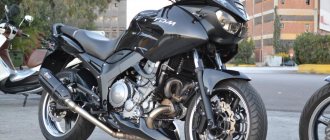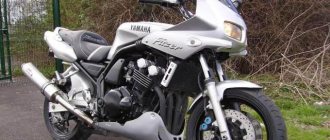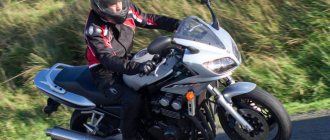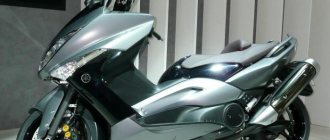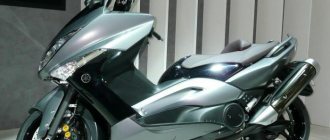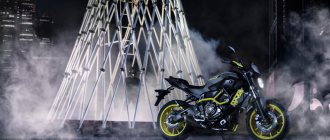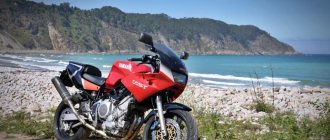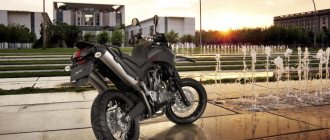Appearing in parallel with the diversion 400, in 1992 the Yamaha diversion xj 600 s was sent directly to export markets. In the final set, this saved her . If the 400 only lived for a few years, the 600 cm3 was produced for 10 years . It received 1 restyling, and one modification was released on its basis. The last bike will leave the assembly line in 2002.
Later in 2009, the model received a successor, the Yamaha XJ6 Diversion. It has been in production for 8 years , and in 2017 it also closes.
Yamaha XJ600S Diversion 97. Motorcycle reviews, test drives
Go to page
Goldberg007
Guest
Dear forum users, I want to tell you about a motorcycle like the Diversiya 600 of the previous generation, namely the 1997 model.
Link to the video on YouTube (not mine and sabotage before 97, but it will be clear what it is) https://www.youtube.com/watch?v=UxGHq5kpEOc
Number of cylinders 4 Number of valves 8 Cylinder arrangement In-line Volume 599.00 cm3 Power 60.90 hp At speed 8500 rpm Torque 53.00 Nm Number of strokes 4 Cooling system Air with oil cooler Bore / Stroke 58.5 x 55.7 mm
DIMENSIONS AND WEIGHT Dry weight 195.0 kg Fuel tank capacity 17 liters. Front wheel size 110/80-17 57H Rear wheel size 130/70-18 63H Seat height 770 mm Wheelbase 1,445 mm Overall length 2,170 mm Overall width 735 mm Overall height 1,090 mm Ground clearance 150 mm
Front brakes Single disc Rear brakes Single disc Front brake diameter 298 mm Rear brake diameter 245 mm Front suspension travel 140 mm Rear suspension travel 110 mm
My opinion and description
.
So. I bought it for 122 thousand rubles. Mileage 26 thousand km. Condition is good. Compression is normal.
I managed to drive almost 4 thousand km on it.
Consumption from 4.2 liters when driving on the highway at 120 km per hour and up to 6 liters in the city in traffic jams and when torsionally. I drive quite calmly and very rarely the engine spins above 7 thousand revolutions, and the speed is above 120 km per hour.
Comfort. I drove a maximum of 120 km in one sitting and then my backside starts to ache. It's a matter of habit, as the seat is soft and wide.
All switches are at hand, there is a flashing high beam and emergency lights.
At 120 it doesn’t blow, I sit straight.
The pendants work very well. When braking sharply, the front bites noticeably, but this device is not for sports driving. By the way, the vehicles that came out in 1998 are equipped with two brake discs in the front, but since they were much more expensive on the Internet, and the condition was rated much worse and the driving style did not imply braking from 200 km per hour, I decided to buy the device whose condition I liked it the most. I bought it with a 33-liter case and good consumables in the form of new rear tires and a slightly worn front tire, as well as a live set of sprockets and chain.
I don’t really feel the rutting of the road, since the stock rear tire size is 130, mine is 140.
The device drives very well in a straight line, bumps are absorbed, there has always been enough power and the same with the second number. It holds its course confidently in turns.
The engine spins from the bottom up to almost its red zone of 9500 rpm.
Very nice little things
, some of which I got very used to in Yubra, namely: - the center stand!! — fairing. — handles on the passenger side. — inspection window for oil level. — o-ring chain. — “flashing” high beams and emergency lights. - light. it was unusual when the fairing was in place and did not turn with the steering wheel) - the gas valve has 3 positions: “reserve”, “open” for draining fuel and the “on” position. In the “reserve” and “on” positions when the engine is turned off, gasoline does not flow (no vacuum). That is, the tap always remains in the on position and is not touched unless necessary.
The disadvantages are obvious and not very.
— vibration from 4-5 thousand rpm is significant, then it decreases. but there will be vibration on any rather large engine. — the device is not light, so you need to be more careful with the gas and brake when turning. It’s much harder to push than a Ubr, but it rides excellently and comfortably on the highway. — an air vent, so it works with a clanging sound and it seems like something is wrong. Treated by a trip to a couple of services for personal reassurance. — we can attribute the presence of a fuel pump, which reduces reliability.
Optional equipment:
— engine oil temperature sensor — 30 euros, https://www.louis.de/_20f54cbc695cb5e. nr_gr=10034300 - drain bolt with magnet - 5 euros, https://www.louis.de/_20f54cbc695cb5e. nr_gr=10002912 - chrome holder for watch and thermometer - 15 euros + watch 15+ thermometer about 15 euros and it turned out https://www.louis.de/_20f54cbc695cb5e. TITLE=10034516 - cigarette lighter also from Louis - 12 euros.
Rem zone.
I changed the consumables myself. — You need about 3 liters of oil, about 1,500 rubles. - 4 candles for 300 rubles each = 1200 rubles. — air filter 800 rubles. — oil 400 rubles. — a chain with Regina stars on Louis was bought for 3200 rubles, o-ring. The DID cost 5,000 rubles, but I didn’t have time to buy it and now it costs 6,000 rubles. — cleaning and synchronization of carburetors — 3500 rubles.
Everything is easy to access, I removed the tank (2 bolts) and here is the air filter housing, underneath there are 4 carburetors. Remove the fairing for 5-6 minutes and here you have the tidy and everything else.
Let me summarize.
I chose the device for a long time, approaching the choice intelligently. I started my choice, as always, with standard devices like SB400, then SB 750, but the condition and price did not correspond to reality. And I also decided to choose a device that is not popular with smart guys, so that it is not worn out and the mileage is not in the second round.
This is the device that you sit on and don’t pay attention to any nuances both in driving and driving in traffic jams or on the highway, this is exactly what I wanted. I sat down and drove off. There was no need to get used to anything.
I caught myself thinking that I couldn’t choose a replacement for it, even if I wanted to, because: 1. comfortable both in the city and on the highway. 2. a calm motorcycle and suitable for anyone. 3. unpretentious, reliable, simple motor. 4. Comfortable seating for both driver and passenger. 5. I love the balanced look, namely 2 chrome-plated exhaust pipes) 6. The dimensions are small in width and large in length, and I have an air mattress or tent placed between the trunk and the seat. 7. versatility, I drove on sand, on broken asphalt and on country roads. 8. I like the style of those years. 9. made very thoughtfully and of high quality.
Flaws
We talked about a comfortable fit, but if you are taller than 190 centimeters or heavier than 90 kilos, then this is out of the question.
Moreover, with such physical indicators, not only will it be uncomfortable for you to sit on a motorcycle, but it will even be difficult to see anything in the rearview mirror. The low seating position of the motorcycle sometimes leads to the rear footrest touching the asphalt surface when cornering, and the brackets that hold the footpegs are weak and bend easily. But this is a feature of the model, you just need to get used to it by slightly adjusting your driving style. Not very good front light is also a drawback, but it can be eliminated by replacing the lamp and fine-tuning the optics.
Specifications
Owner review
It so happened that by the summer of last season I prepared like a bad student to take the exam. Everyone has been driving around for a long time, friends are inviting me to outings, but I’m sitting without a device. Although I tried a lot of options before this. And so, I finally gave up on the weight of the matter and headed off to Germany in search of a decent option at a good price - I didn’t want to overpay on the spot, and there was an exciting trip ahead - what’s not an extreme vacation?!
Having searched at local outlets, I found the xj 600 diversion among the worthy options. I won’t say that I was very excited - after all, I’m an experienced wolf in motorcycle matters. But I took a closer look, asked the price and came to the conclusion - we should take it, and then we’ll see how it behaves. To be sure, of course, I read reviews about the Yamaha Diversion 600, but I didn’t read anything worthwhile for myself. But. I was driving home already on it - I covered about three rubles of mileage from old Europe to home. I must say that along the way my skepticism gave way to almost delight in this motorcycle. I still don’t understand why this model is so underestimated and placed next to the tired 400s.
Judge for yourself: — customs clearance is small due to the small volume; — the engine runs smoothly, without jerking, but the traction is decent; — cooling is purely air-based and does not create any problems;
The transmission is annoying because the clutch is too noisy. But the gearbox itself is 5-speed and works clearly and smoothly. Of all my previous Japanese cars - Hondas, Suzukis, this Yamaha is in first place in the box. The softness of the suspension is also excellent, and not punchy. In my opinion, the fork feathers are a little thin, but this is a matter of taste. Since the Yamaha XJ 600 is moderately dynamic, the braking system and its reaction are sufficient. Everything is placed as comfortably and conveniently as possible, I rolled up to a thousand a day without fatigue or complaints from the fifth point. Wind protection rolls, promotes and direct fit.
I didn’t overweight it, but according to the catalog they say that the weight of the motz is 187 kg – and it feels like it has excellent handling. Made just for my height of 181. The consumption is also pleasing - some 4.5-5 liters at cruising 140 per hour. Although this is on European autobahns, it comes with all the luggage and frequent overtaking. I gave the maximum up to 170 on the Yamaha XJ 600 S, I didn’t take much risk, so as not to sow things along the road. The tank lasts for 300 km, on average, in different modes. In short, it seems like all the parameters are at the average level. But pay attention to the price - what else will you find for that kind of money - that's right, you will only find worse.
For long-distance tours and with a limited budget, the purchase is just right for me; I haven’t seen anything better either from friends or online. Honestly, I would buy it again if I could turn back time, so I don’t regret it. I advise you to buy a Yamaha xj 600 s if you are tight on money but want comfort. For those who have not yet decided, I will summarize the advantages: super price, the highest possible comfort for this class, simple maintenance, excellent design. Well, to be honest, about the disadvantages: the cooling is exclusively air-based - minus one, but significant. Then it's up to you. Review of Yamaha xj600, left by Kostya from Moscow
Brief history of the model
1992 - start of production and sales of the model. Model: Yamaha Diversion 600 / Seca II (Europe, North America). Factory designation: 4BR1, 4BR2, 4DG1, 4DS1, 4DU3, 4EB1.
1993 - no significant changes. Model: Yamaha Diversion 600 / Seca II (Europe, North America, Japan). Factory designation: 4BR3, 4BR4, 4DG2, 4DS2, 4HK1, 4EB2.
1994 - appearance of the naked modification. Model: Yamaha Diversion 600 / Seca II; Yamaha Diversion 600 (Naked) (Europe, North America, Oceania). Factory designation: 4BR6, 4BR7, 4DG4, 4EB4, 4KA1, 4KE1, 4KE2, 4KF1, 4LX1, 4MB1.
1995 - no significant changes. Model: Yamaha Diversion 600 / Seca II; Yamaha Diversion 600 (Naked) (Europe, North America). Factory designation: 4BR8, 4BR9, 4DG5, 4DUC, 4EB5, 4KA2, 4KE3, 4KE4, 4KF2, 4LX2, 4MB2.
1996 - no significant changes. Model: Yamaha Diversion 600 / Seca II; Yamaha Diversion 600 (Naked) (Europe, North America). Factory designation: 4BRA, 4DG6, 4DUF, 4EB6, 4KA3, 4KE5, 4KE6, 4KF3, 4LX3, 4MB3.
1997 - no significant changes. Model: Yamaha Diversion 600 / Seca II; Yamaha Diversion 600 (Naked) (Europe, North America). Factory designation: 4BRC, 4BRD, 4DG7, 4EB7, 4KA4, 4KE7, 4LX4, 4MB4.
1998 - restyling of the model. The model receives an increased thickness fork (38 → 41 mm), a 2-disc front brake (instead of a single disc), an oil cooler and new versions of carburetors. Model: Yamaha Diversion 600 / Seca II; Yamaha Diversion 600 (Naked) (Europe, North America). Factory designation: 4BRE, 4DG8, 4EB8, 4KA5, 4KE9, 4KF5, 4LX5, 4MB5.
1999 - no significant changes. Model: Yamaha Diversion 600; Yamaha Diversion 600 (Naked) (Europe). Factory designation: 4BRF, 4DG9, 4EB9, 4KA6, 4KEA, 4KF6, 4LX6, 4MB6.
2000 - no significant changes. Model: Yamaha Diversion 600; Yamaha Diversion 600 (Naked) (Europe). Factory designation: 4BRG, 4DGA, 4KEB, 4KF7, 4LX7, 4MB7.
2001 - no significant changes. Model: Yamaha Diversion 600; Yamaha Diversion 600 (Naked) (Europe). Factory designation: 4BRH, 4DGB, 4KEC, 4KF8, 4LX8, 4MB8.
2002 is the last year of production. Model: Yamaha Diversion 600; Yamaha Diversion 600 (Naked) (Europe). Factory designation: 4BRJ, 4DGC, 4KED, 4KF9, 4LX9, 4MB9.
Owners of Yamaha Diversion XJ600 - unite!
6 years on the site user #898979
I am looking for happy owners of this Yamaha model, both beginners and experienced ones, to jointly discuss both achievements and problematic issues. Personally, I have a Yamaha Diversion XJ600 N - the first motorcycle that appeared in December last year, so before the start of the season I want to discuss everything that concerns my iron friend! Fans of this legendary (and inexpensive) motorcycle - write, we’ll get to know each other. PS Why not create a kind of Diversion Club, “Saboteurs Club”.
9 years on the site user #272503
Is the Yamaha XJ6N suitable? Without "00". I have one like this.
13 years on the site user #83527
this legendary
(and inexpensive) motorcycle
ummm. Sorry, but where can I read the epic?
6 years on the site user #898979
Well, if we consider this model an updated classic, then it will do! What year, how does the moto feel?
this legendary
(and inexpensive) motorcycle
ummm. Sorry, but where can I read the epic?
Well, can’t a motorcycle that has been in production for almost 11 years already be considered epoch-making?
9 years on the site user #272503
leo2808
, 2012 release. This is my first motorcycle, so it’s difficult to give an objective assessment - there’s nothing to compare it with. I took it new from the dealership in the summer of 2012, only had time to drive it for a little over a month and broke my leg. Last summer I just had time to break-in, so this year I can already spin it at more than 7000 rpm. The engine is stifled, smooth, high-torque without wild pickup, but this is good for a beginner. I have already tested ABS several times, it is a necessary thing. Something like that.
6 years on the site user #898979
leo2808
, 2012 release. This is my first motorcycle, so it’s difficult to give an objective assessment - there’s nothing to compare it with. I took it new from the dealership in the summer of 2012, only had time to drive it for a little over a month and broke my leg. Last summer I just had time to break-in, so this year I can already spin it at more than 7000 rpm. The engine is stifled, smooth, high-torque without wild pickup, but this is good for a beginner. I have already tested ABS several times, it is a necessary thing. Something like that.
So you haven’t traveled before (just like me)? Who did you learn management from? Another question for you: you took a new bike from the salon, even though you are a newbie. Didn't you feel sorry for taking it to gain riding skills? I took a different route, took a 2000, it’s solid, without any problems, I just bought consumables and spare parts like chains, sprockets, spark plugs, etc. By the way, I want to make myself a cage - protection from possible encounters with asphalt)
9 years on the site user #272503
I studied with Dima-Klyuch. Five days in a row for two hours. There I actually got on a motorcycle for the first time in my life. Then I studied at Semashko for two or three days. It's purely for passing the category. Passed the first time Regarding “it was a pity to gain skills” - I don’t quite understand the question. As a beginner, on the contrary, I drove very carefully, and the run-in did not allow me to turn it more than 5000. I put protective bars on it. For a season and a half, I never dropped the motorcycle (tfu-tfu-tfu). I have been driving a car for 15 years. The XJ6 is a motorcycle for learning, and in all tests it is characterized as such. Right now I really like the Yamaha MT-09. I’m thinking of riding the XJ6 this season, and switching to the MT-09 in 2015. I don’t like sports bikes, I don’t see the point in being a sports tourist - I travel by car. Something like that.
6 years on the site user #898979
I also studied with Dima Klyuch last September, no matter what I did, he was calm, like an elephant) He explained and showed very clearly (in the beginning of spring I will also ride with him). I also read about MT-ku, the characteristics are quite suitable and it looks good. After my 61 hp. An MT-shka with 115 will seem like a racing one)) I’m looking forward to a more serious one, having already skated at least 1 season. How long did the max speed survive from his Sabotage??
6 years on the site user #898979
Are you also planning a Yamaha next?
9 years on the site user #272503
leo2808
, The maximum was about 140 km/h. This is a maximum in 6th gear of about 6000 rpm, and the motorcycle is running in. Yes, and it was scary to go faster, but I still have time. Besides, I don't enjoy the top speed of either a car or a motorcycle. I prefer to maneuver between cars at speeds of 80-90-100, take off, and turn with a squeal (for now only by car). I once trained with our Sergei Ovchinnikov (Belarus rally champion) about five years ago. So there at a speed of 80-100 you can get a lot of adrenaline. But pressing the pedal (turning the knob) all the way doesn’t require much intelligence. I’m planning the next one, also a Yamaha. I like the MT-09, Bolt and XVS1300A Midnight Star. I know they are completely different. But if things go well, then why not have two motorcycles at once? It’s too early to guess.
6 years on the site user #898979
However. Can you handle servicing 2 at once?) By the way, I took short lessons in emergency driving with Ovchinnikov in 2011. When you listen to the theory, it’s all just pure physics! It’s a pity that the lessons didn’t last long, and the machine gun is now on the car; it doesn’t seem to work that way with it. By the way, have you changed the chain yet? I’m thinking, don’t bother yourself, give it to a specialist.
9 years on the site user #272503
The motorcycle is new, under warranty. My mileage is low. Maintenance only includes oil and filter. Well, check. Now I want to change my exhaust, the original one is very quiet. The exhaust manifold (spider) is of a non-standard shape, so just replacing the can will not do, you need to change it completely. There are many options. For now I’ve settled on Arrow, if I can’t find it myself in Poland-Lithuania, then I need to look for someone who can bring it from the USA.
6 years on the site user #898979
I wanted to ask: did you quickly learn to drive in the city? And how do you stay in line relative to the dividing lines and other cars?
Front fork
General information:
- The diameter of the fork leg is 41 mm.
; - The oil used is Suspension oil 01 Yamaha with a viscosity of 5w
in each leg of
473 cm3
(about one liter of oil is needed to repair the entire fork); - Fork seal size: 41x53x11 mm.
; - Fork spring length: 365.1 mm
.
Original spare parts:
- Oil seal, one per package: 5VU-23145-00-00
(Normal price - $11). - Boot, one per package: 3VD-23144-00-00
(Normal price - $15). - Upper fork guide: 3VD-23125-10-00
(Normal price - $14) - Lower fork guide: 3VD-23135-10-00
(Normal price - $11)
Analogues from All Balls Racing:
- All Balls 56-156
boot and seal kit (two boots, two seals in the box) - $28 - Oil seals only (2 pieces per box) All Balls 55-116
- $14 - Anthers only (2 pieces per box) All Balls 57-143
— $15
Functions of instruments and controls
- Image
- Text
3
INSTRUMENT AND CONTROL FUNCTIONS
Main Switch/Steering Lock ………………………………………….. 3-1 Steering Lock (Model XJ600N) ………………………………………………………………… ……… 3-3 Indicator and warning lights ………………………………………… 3-3 Speedometer (XJ600S model) ………………………………… …………………… 3-4 Speedometer (model XJ600N) ……………………………………………………… 3-5 Tachometer ……………………… ………………………………………………………………………………….. 3-5 Switches on the handles ……………………………………………………………… …………… 3-6 Clutch lever ………………………………………………………………………………………. 3-7 Gear shift pedal ………………………………………………………….. 3-8 Brake lever ……………………………………………………………… ……………………………… 3-8 Brake pedal ……………………………………………………………………………… 3-9 Fuel tank cap ……………………………………………………………… 3-9 Fuel ……………………………………………………………… ………………………………………… 3-10 Fuel tank breather hose (Germany only) ……..3-11 Fuel tap ………………………………… ……………………………………3-11 Starter lever (choke) …….. 3-12 Seat ……………………………………………………………… ……………………………………………………………….. 3-12 Helmet holders ……………………………………………………………… 3 -13 Luggage compartment …………………………………………………………………… 3-14 Shock absorber adjustment………………………………………………………… ……………….. 3-14 Luggage strap holders ……………………………………………………. 3-15 Side stand………………………………………………………………………. 3-15 Ignition interlock system ………………………………………………………… -316
4BR-28197-R8-3.pmd
2003/05/22, 14:49
18
Results
The motorcycle is worth the money they ask for it. The model is not suitable for experienced motorcyclists due to its lack of power and aggressive character. For beginners or lovers of measured riding, this behavior of the motorcycle is undoubtedly a great advantage.
Yamaha XJ6 is a simple and inexpensive model, unpretentious and unbreakable. A motorcycle without any obvious “blunders” or any design flaws. As a bonus, you get a stylish and modern design that looks much more expensive than it actually is.
With such a motorcycle you won’t be able to stand out among experienced motorcyclists, but you will always be able to make a splash on beginners or people who are far from the world of motorcycles. Moreover, everyone's tastes are different; not all motorcycles need to be super powerful and move at jet speeds.
Prices
The cost of a used model in our country starts at 250 thousand rubles. The average price of a motorcycle without mileage in Russia is from six thousand dollars. As a rule, the condition of imported motorcycles is much higher. But when buying at an auction abroad from home, you must understand that you are assessing the condition based on the photo. The Yamaha XJ6 is a reliable motorcycle, and motorcyclists abroad are responsible people, but there is a risk of running into a careless fraudster.
It is quite possible to find a decent motorcycle in our country with mileage throughout Russia. You need to thoroughly check the motorcycle before purchasing in order to know about all its subtleties and nuances. The surest option, if your funds allow you, is to personally go abroad to buy a motorcycle, choose the best one, bring it into Russia, go through customs clearance and then enjoy your new bike in perfect condition.
Optional equipment
The manufacturer has developed a lot of additional equipment and accessories for this model. Almost all of them are aimed at making travel on this motorcycle more comfortable, especially when it comes to long trips. Provided:
- Protective bars for the driver.
- Engine protection.
- Special linings for the fuel tank.
- Tank bag.
- Central stand.
- The top case has a volume of almost (40 liters and 50 liters). The case is equipped with a backrest and an internal bag.
- Aluminum trunk.
This is not a complete list of “extras”; we have listed only the main accessories that are relevant for long trips.
A new version
The new Yamaha XJ6 Diversion is a completely different motorcycle. It doesn't have the disadvantages of the first generation. And the price is very, very attractive. The model is perfect for beginner motorcyclists.
In general, the Yamaha XJ6 is a kind of variation of the Yamaha FZ6 (this unit has been sold in Europe instead of the XJ6 since 2009). In the American market, the XJ6 is called the Yamaha FZ6R. The appearance of the Yamaha XJ6 motorcycle in Europe is associated with the desire of the company's management to offer motorcyclists a low-power and budget model that would be aimed at the maximum number of potential buyers. The XJ6 is much cheaper in price, taxes and insurance than the original Yamaha FZ6 (98 horsepower engine).
It is worth noting that many manufacturers try to create very powerful and fast motorcycles, but for some reason they sometimes forget about transport for beginners. But this is more than it seems at first. This is a model for beginners, for girls, and for those who simply love measured motorcycle riding. It is very gratifying that at least someone produces real things for this large category of buyers.
